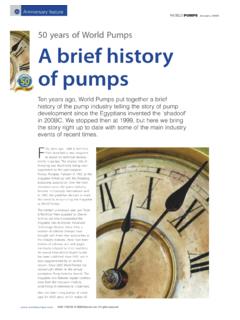Transcription of CHAPTER 1
1 SMALLPOXCHAPTER 1 eradicating an ancient scourgeEastern Nigeria, December 1966. !e message came through on the radio a crackly transmission car-rying news of a smallpox outbreak in the bush. !e missionaries had set up a ham radio network covering parts of the Ogoja region of eastern Nigeria where they were working in support of the country s national smallpox campaign. Every day at 7 pm they tuned in to share news and check that none of them had fallen ill. !e report ended with a request for Dr William Foege to come out to the village and take a look. Foege had his doubts. He had been working in Nigeria as a medical missionary long enough to know that chickenpox was sometimes mistaken for the far more serious disease. However, he knew that only around 35% of the popula-tion was supposed to have been vaccinated against smallpox in that region.
2 And an outbreak, even if only rumoured, was too important to be ignored. So Foege and his team set o# that day, bumping their way over rutted roads, eventually $nding the village 15 km from the an ancient scourge31 When countries gather for the World Health Assembly each year one question often comes up: whether or not to destroy the last remaining stocks of the smallpox virus. That is a choice we have thanks to the relentless pursuit of the smallpox virus by health workers across the always when the imposing two-metre tall Foege showed up, a crowd gathered. Foege spoke to the head of the village and was taken from hut to hut, registering the scared faces and looking for the tell-tale signs of smallpox. As with chickenpox and measles, a person with smallpox develops a the chickenpox rash which develops over a couple of days, small-pox comes up very quickly in a rash that is also more dense on the face, hands and feet.
3 !e red spots swell, $lling with %uid until the pea-sized poxes become hard. As the disease progresses, the pustules continue to erupt under the skin, spreading over the face, body and hands until the victim s body is almost entirely covered (Photo ).It didn t take long for Foege to validate the report. !is was indeed smallpox, and now he had a problem: fresh supplies of the vaccine and more vehicles were not due to arrive for several weeks. Whatever Foege and his team were going to do, they would have to do it quickly. !at night he and his colleagues decided that the $rst step was to get a picture of the extent of the outbreak. !ey started by using a map to divide the area around the a#ected village into manageable sections. !en they got on the radio and called on other missionaries to send runners to the surrounding villages to $nd out if they had more they had an accurate map of the epidemic, Foege and his team went into the a#ected villages and, using the limited supplies, vaccinated people who hadn t yet caught the disease, ring-fencing the hot spots with a barrier of immunity.
4 It was a good start, but on its own was not going to be su&cient to stop the disease. !ere were going to be travellers who had no idea they were infected and who would spread the virus around the region. Foege knew that the battle against smallpox would be won or lost depending on how well his team handled these learnt that people regularly traded goods at designated locations, each market serving several villages. With this information, he mapped out local transportation and trade routes. What was le' of the vaccine was com-mitted to building rings of resistance in the areas he had mapped out that were most likely to see new cases. At the end of the $rst week Foege s response to the outbreak was in place. Now all he could do was watch and , drugs & smokePhoto Somalia, 1970s. A mother holds a child whose body is almost entirely covered with smallpox pustulesWHO/J.
5 Breman5 Smallpox5 When WHO was foundedIn 1948, when the World Health Organization (WHO) came into being, the smallpox virus was infecting about 50 million people a year the equivalent of the population of South Africa. In many ways, it was exactly the kind of adver-sary that WHO was expected to take on a global heavyweight of disease that was beyond the scope of any individual nation to by the variola virus, smallpox is one of the most devastating diseases known to humankind (see Box Fact $le smallpox). Prior to 1960, smallpox ranked with malaria and tuberculosis as the main causes of death due to infectious disease. In 1967, there were around 10 15 million cases of smallpox in the world each year, a $gure which had dropped from around 50 million cases a year in the 1950s. One group of experts has estimated the global death toll from smallpox during the 20th century to have been around 300 million.
6 !is contrasts with, for example, a recent estimate by the New York Times that 100 million people died during the 20th century either directly or indirectly as a result of war and armed con%ict.!e fear that smallpox struck in people was extraordinary. Until the vaccine was developed and widely available in the 20th century, many societies independently of each other developed a technique known as variolation. !is involved inoculating a healthy person with the dried scabs of someone with smallpox, giving that person a mild form of smallpox. But the method was not without risk, 1 2% of those variolated in this way died, compared with up to 30% of people who died when they contracted the disease itself. Smallpox was so frightening that people were prepared to risk death to become Fact file smallpoxWhat is smallpox?
7 Acute contagious disease caused by a : 3000 years ago in Egypt or family: Poxviridae or : Variola minor (killed one in 100). Variola major (killed one in three).Transmission: Airborne : There is no cure, but vaccination can be used ver y ef fectively to prevent infection from developing if given during a period of up to four days after a person has been exposed to the after eradication: V ir us s to ck s kept in high-security Russian and USA smallpox virusCDC6 Governments $rst seriously discussed the possibility of eradication in 1953 at the annual World Health Assembly, but there was little enthusiasm for the idea. Sceptics pointed to several failed attempts to eradicate other diseases, including hookworm at the turn of the 20th century, while e#orts to stamp out yellow fever had been called o# in 1932, when scientists discovered that mon-keys were regularly being infected with the virus, thus putting it out of reach of an eradication campaign targeting humans.
8 !e World Health Organization s own campaign to eradicate malaria was just getting under way in the 1950s a massive undertaking that succeeded in some countries of the Americas, Asia and Europe, but failed in widespread doubt in the 1950s that any disease could be eradicated, it required someone with more than just technical knowledge of smallpox con-trol to give WHO s programme its $rst real impetus. Soviet scientist, Viktor Zhdanov, was just such a man. Speaking at the World Health Assembly in 1958, Zhdanov, an epidemiologist by training and deputy health minister of the what was the Soviet Union at the time, called for the total eradication of the virus (Photo ).Inspired by Soviet successComing from anyone else, this might have seemed like a dream, but Zhdanov carried considerable in%uence.
9 He had seen smallpox contained in the Soviet Union in the 1930s, and although the disease remained a problem in the cen-tral Asian republics where cases were coming in from Afghanistan and Iran (today the Islamic Republic of Iran), Zhdanov saw no reason why Soviet suc-cesses could not be repeated elsewhere. He proposed a four-year global vac-cination campaign starting in from his own experience of running an eradication campaign, Zhdanov also brought his belief in a technique known as lyophilization or freeze-drying (Photo ), which had been developed during the Second World War to meet demand for reliable stocks of dried blood plasma. Research in the 1950s had shown that several pharmaceutical products could be preserved in this way. Smallpox vaccine was one of vaccine is easily transported and can be reconstituted when needed, unlike polio vaccine, for example, which has to be refrigerated, greatly Bugs, drugs & smokePhoto 1.
10 2. USA, 1960. Russian scientist Viktor Zhdanov (right)WHO/M. RudePhoto 1. 3. India, 1962. Freeze-dried smallpox vaccine being prepared at the King Institute of Preventive Medicine in Madras (today Chennai) in the Indian state of Tamil NaduWHO/ Sharma7 Smallpox7complicating the task of getting it into the $eld. Zhdanov believed that freeze-dried vaccine would be an essential tool in WHO s smallpox eradication programme, and said his own government was ready to fur-nish WHO with supplies.!e Soviet Union was not the only country to have contained smallpox. Most other industrialized nations had done so by this time too, but the disease remained endemic in many developing countries (see Box From widespread to wiped out). Zhdanov convinced WHO Member States of the merits of his plan and at the next World Health Assembly, also in 1959, they voted unanimously in favour of starting a global small-pox eradication campaign.

















